Resources
 Part of the Oxford Instruments Group
Part of the Oxford Instruments Group
Expand
Collapse
 Part of the Oxford Instruments Group
Part of the Oxford Instruments Group
C-RED 2 Lite is a 640 x 512 stabilized SWIR camera running at 600 FPS full frame. The camera design optimizes temperature management and enables precise sensor stabilization despite environmental fluctuations. This, in turn, opens the door to quantitative applications such as laser beam profiling, hyperspectral imaging, thermography, etc.
Monitoring sensor temperature can have distinct goals:
There are multiple means to cool down a sensor, the general idea is always to dissipate heat away from the sensor. In First Light Imaging cameras, this can be achieved through the following means:
These methods can be implemented intrinsically in the camera to dissipate heat away from the sensor or externally to dissipate heat away from the camera. Combining techniques results in optimal temperature management performances. In many cases though, a compromise has to be found between performance and added weight and power consumption.
First Light Imaging offers a complete portfolio of InGaAs-based cameras with different intrinsic temperature management options and external cooling means.
 |
|
In the C-RED 2 Lite camera, the sensor is stabilized by a thermoelectric cooler (TEC) and integrated in a compact and rugged high-speed SWIR camera.
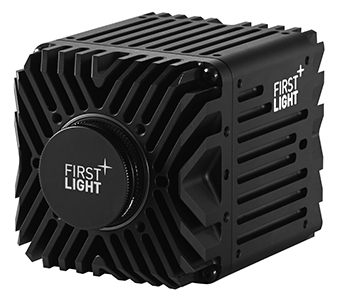
C-RED 2 Lite camera
The important advantage of the C-RED 2 Lite camera is its temperature management robustness and versatility:
C-RED 2 Lite does not make any compromise on camera performances:
In C-RED 2 Lite, the sensor is stabilized using a thermoelectric cooler. The camera internal design transfers the heat generated on the TEC hot side to the camera case homogeneously. With this design, a delta up to 25°C can be obtained between the case temperature and the sensor temperature.
To obtain the lowest sensor temperature setpoint the challenge is to dissipate the heat away from the camera case. The lower the temperature of the camera case is kept, the lower the temperature of the sensor can be set as well. For this reason C-RED 2 Lite is designed for optimized thermal dissipation.
First Light Imaging offers a wide range of passive and active thermal management solutions, as well as recommendations to adjust the method to your application. The solutions proposed are ordered from the simplest to the most effective:
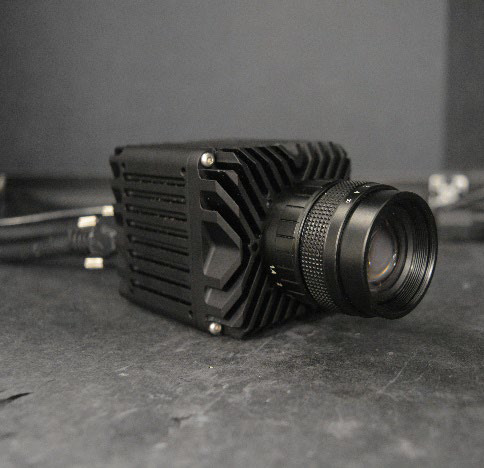
Example of a configuration with increased surface exchange
The effectiveness of passive dissipation is related to the total exchange surface. Any item that increases the surface of thermal exchange will optimize the dissipation, for example:
1. A lens in front of the camera
2. Attaching the camera to a metal board
In such a design, the heat generated in the camera core will dissipate to a larger metal surface. Then, this large surface will exchange heat with the surrounding environment. For example, screwing the camera to the base frame of a large instrument is one way to increase surface exchange.
The larger the contact surface with the camera, and the larger the metal part, the higher the performance gains.
Further increasing the exchange surface area with the surrounding environment can be achieved with a passive component: heatsinks. It is possible to mount up to three custom heatsinks on the camera.
Without forced airflow, the average improvement that can be obtained on the case temperature is the following:
| Number of heat sinks | Case temperature decrease |
| 1 | - 7 °C |
| 2 | - 11 °C |
| 3 | - 11 °C |
Expected camera case temperature drop compared to the reference scenario of zero heat sinks
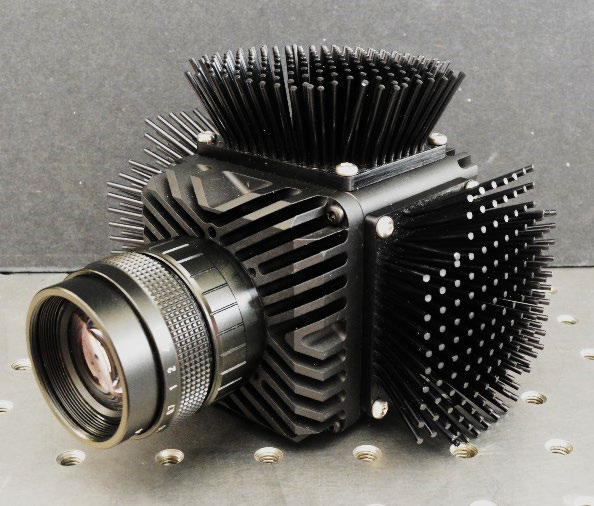
Passive heat sinks set-up
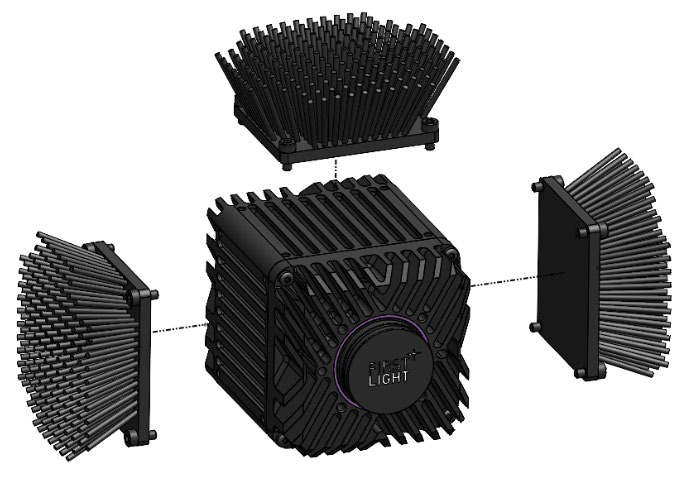
Position of the three heat sinks
An inexpensive way to improve thermal performances is to add an external fan blowing on the camera housing. Any fan can be used for this purpose. For utmost performance, this solution can be combined to the passive heat sinks. Depending on the airflow velocity, the case temperature will significantly decrease. Although very simple to set up, this solution has obvious disadvantages such as vibrations, noise, dust, or atmospheric disturbance.
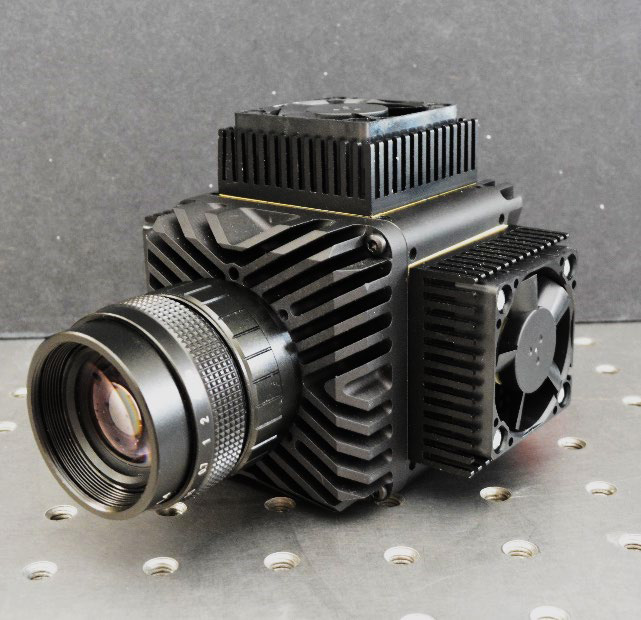
Example of a configuration with an external fan
The finest heat dissipation performance is obtained with the hydraulic cooling plate designed for C-RED 2 Lite. It will provide the highest cooling efficiency, without the drawbacks of forced air convection.
The cooling plate is used in conjunction with a water-cooling system. First Light Imaging recommends using an active system, but a passive one can also be used. With an active system the water temperature is monitored and the camera case can be thermalized at the required temperature.
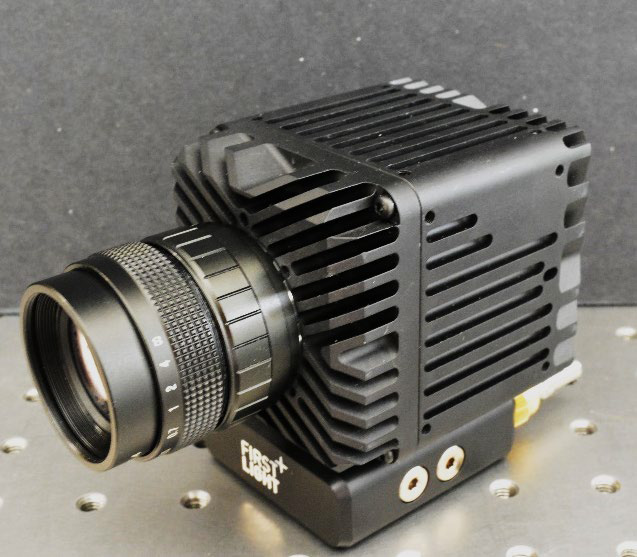
Hydraulic cooling plate set-up
With the cooling plate, the following sensor temperatures can be reached in a 25°C ambient environment:
| Water temperature | Sensor temperature |
| 20°C | 10°C |
| -5°C | -15°C |
Expected sensor temperature, as a function of water temperature
When implementing this solution, one should watch out for the dew point. Going below the dew point may damage the camera, as condensation will appear.
First Light Imaging can supply a full cooling pack including the chiller, hoses and spill-free connectors.
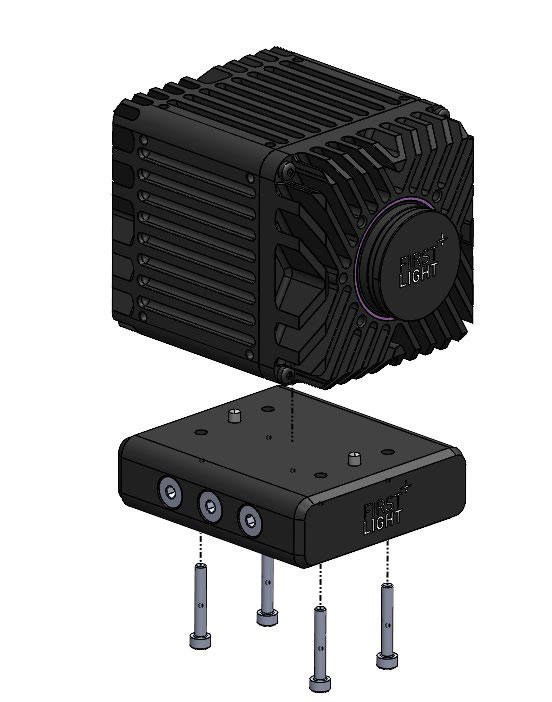
Schematic of hydraulic cooling plate installation
C-RED 2 Lite is a high-performance camera designed for high flux short wave infrared applications. The camera can reach 600 FPS in full frame. Thanks to this, C-RED 2 Lite is very flexible and can be used for a large scope of applications!
Particular efforts have been put on the thermal management of the C-RED 2 Lite camera. The thermoelectric cooler enables to reach a delta up to 25°C between the sensor and the camera case. Multiple options are then available to cool down the case: increasing the heat exchange surface, adding heatsinks, screwing a hydraulic cooling plate, etc. Thermal management ensures that the sensor temperature is stable despite the unavoidable fluctuations of the environment. Depending on your integration constraints and your requirements, you can choose whichever solution is best suited.
C-RED 2 Lite
Stabilized InGaAs camera
600 frames per second (full frame)
640 x 512 pixels
15 µm pixel pitch
30 e- readout noise
For inputs on our key application, check out the articles below:
Date: September 2022
Author: Cecile Brun
Category: Application Note
